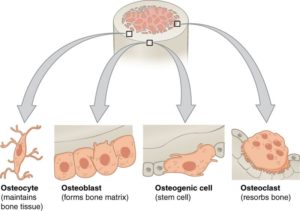Standing, walking, running. When was the last time you gave your skeleton a second thought? How about when that car barely missed you in the parking lot? Or a deer ran in front of you? Maybe you just missed a car door opening on your bike ride today?
Your bones were involved in your response to that sudden shock/surprise, but not the way you think.
You may have jumped, swerved or hit the brake pedal (congratulations on the excellent reflexes) and yes, bones were involved in all of those actions. But a new article in Cell Metabolism reveals that bone is the essential component in initiation of that response.
In an online article in Cell Metabolism, “Mediation of the acute stress response by the skeletion” Berger et al. reveal the surprising findings that bone not only supports muscles, organs and nervous tissue, giving us the ability to run from danger. Bones also generate “a bone-derived signal necessary to develop an acute stress response.”
In studies of mice, rats and humans, exposure to various stressors lead to a rapid and selective surge of the circulating, bioactive form of the bone hormone, osteocalcin.
Here is a little back story on bone, some of it’s surprising uses and how it enables the stress response.
Bone as an Endocrine Organ
We don’t typically think of bone—that hard, calciferous structure that protects our internal organs, and gives us vertebrates the ability to stand and run—as an endocrine organ.
But bone secretes several hormones important in growth and processes carried out by other organs:
• Osteoblasts produce fibroblast growth factor 23 (FGF-23), which reduces the reabsorption of phosphate by the kidneys thus lowering the phosphate level in the blood. FGF-23 is also called phosphatonin.
• Osteoblasts secrete osteocalcin, a hormone that stimulates the beta cells of the pancreas to release insulin. Insulin increases skeletal muscle uptake of glucose, enhancing the capacity to exercise. Osteocalcin release is dependent on the uptake of glutamate by osteoblasts. Glutamate is released by the brain, probably the amygdala, as a response to acute stress.
• Osteoblasts also secrete lipocalin 2, the levels of which rise after a meal and suppress appetite.
Additional Bone Survival Tools
Bone mediates hearing via a series of bony inner ear structures, the hearing bone chain. The ability to hear is another means of responding to stress.
The role of bone in memory is a topic for another blog. Suffice it to say, memory enables wild creatures to not only recall where predators are, but also where they’ve found food.
Berger et al. cited the ability of bone to aid survival in the these means as reason to examine the role of osteocalcin in response to acute stressors.
Other Stress Responses
The acute stress response is evolutionarily conserved. The goal of such a response is to maintain or restore homeostasis in the face of immediate danger. Stress response is marked by elevated temperature, increased heart rate and energy expenditure, and faster respiration. The sympathetic nervous system, considered the ultimate mediator of stress response in vertebrates, releases catecholamine to peripheral organs. Circulating glucocorticoids surge during acute response to stress—but act on the transcriptional level and thus take hours to regulate a physiological response.
Bone-Derived Signal Essential to Acute Stress Response
Berger et al. showed that osteocalcin is essential for eliciting a response to acute stress. Blood levels of osteocalcin surge within minutes in mice exposed to stressors. They further showed that the effect of acute stress on bone is limited to osteocalcin, independent of corticosterone and catecholamine signaling.
Inducing Acute Stress in Animals and Humans
In the studies by Berger et al., I found their study set up and controls particularly intriguing. One stressor used for mice was a small electric shock to the foot. Rats were restrained in order to induce a stress response.
Another stressor used was the compound 2,4,5-trimethyl thiazoline (TMT), a component of fox urine known to induce a rapid, innate fear reaction in mice. TMT, like the other stressors tested, induced elevated bioactive osteocalcin that was measurable before corticosterone levels rose. Osteocalcin peaked at 2.5 minutes and remained elevated for at least 3 hours.
Urine from a nonpredator animal (rabbits) was used as a negative control and did not affect circulating osteocalcin levels.
How to stimulate a stress response in humans? The researchers accomplished this by requiring human subjects to perform public speaking and undergo cross-examination, activities that increased the subjects heart rates and blood pressure.
Summary
Berger et al. showed that osteocalcin mounts an acute stress response by inhibiting the parasympathetic (rest and digest) system. In their studies, animals lacking glucocorticoids and adrenal glands could still show a normal acute stress response, demonstrating the independence of an osteocalcin response from other stress-induced compounds. The authors leave open the possibility that other organs might also contribute to this response.
They noted a rise in osteocalcin within minutes and showed that the stress response was unique to osteocalcin over any other bone-related hormone. Stressors first signal in the brain, generally at the amygdala. Berger et al. showed that the response is independent of glucocorticoids but is dependent on glutamate release.
There is more interesting content in this paper. Read more here:
Berger et al. (2019) Mediation of acute stress response by the skeleton. Cell Metabolism 30, 1–13 (November 5, 2019). Published online ahead of press: https://doi.org/10.1016/j.cmet.2019.08.012

